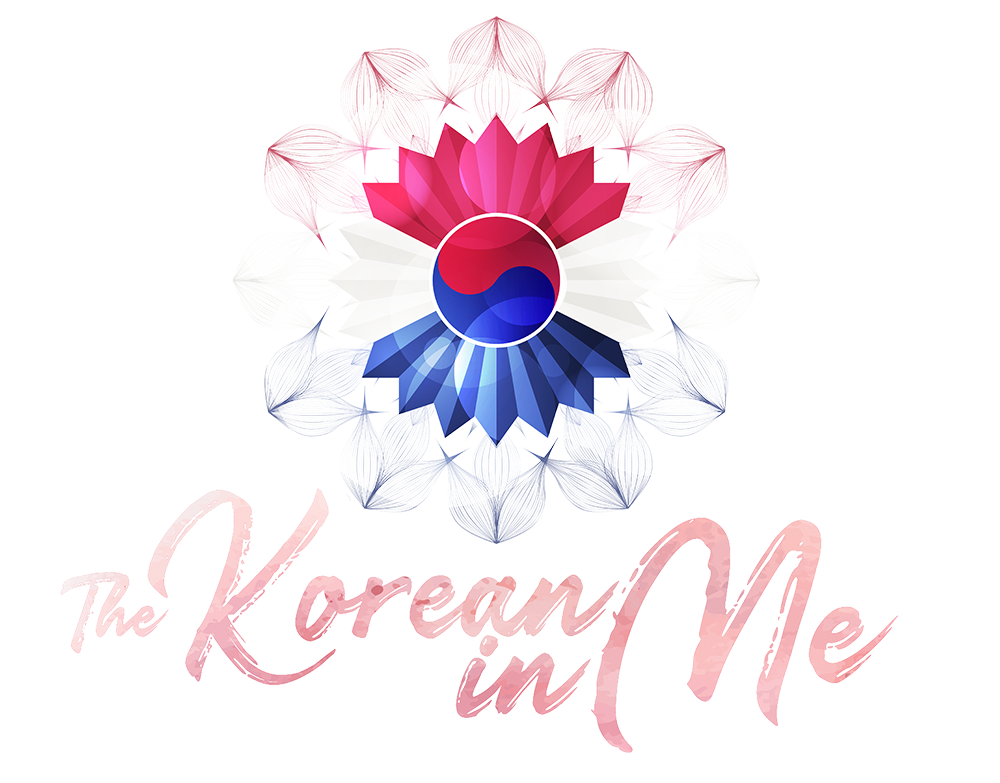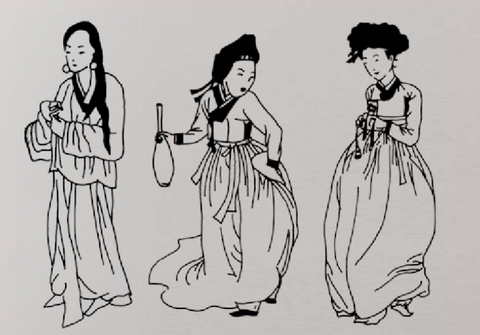What is Women's Hanbok?
Women's hanbok is composed of a chima (a wrap-around skirt) and a jeogori (a top or blouse). It is a different silhouette than any other women's traditional dress out there. Whereas cultural dresses such as the Vietnamese ao dai features a tight-fit silhouette that hugs the body, the hanbok is more fluid and free in its structure.
The variations in women's hanbok mainly come from the different types of jeogori that exist. For example, there is the banhoijang jeogori and the samhoijang jeogori which has different colored patches on various parts of the blouse, and the saekdong jeogori (multicolor striped sleeves).
In this post, we'll cover the main components of the women's hanbok and see what parts you need to wear hanbok beautifully during a Korean wedding or family event or festival celebration. This is your introduction to Korean women's hanbok fashion.
Table of Contents
What does women's hanbok look like?
What are the components of a women's hanbok?
Basic Hanbok terms
The different types of Jeogori (Hanbok Blouse)
The royal blouse, the Dangui
The style evolution of women's hanbok
What does women's hanbok look like?
The hanbok is traditional Korean attire comprising of a jeogori (hanbok jacket or blouse) and chima (skirt). Tightly tied on top and loosely flowing on the bottom, the hanbok harmonizes opposite forces. The spirit of balance is imbibed in hanbok. The jeogori features gentle curves while the skirt flows as naturally as breathing. Designers often say that the jeogori is the epitome of curve aesthetics. With one look, it is easy to understand the aesthetic preferences of the Korean people through the flared bottom hem and soft curves of the low-hanging sleeve of the jeogori.
The tight top and loose bottom became more pronounced towards the late Joseon Dynasty. Though jeogori shrunk and became more constricting, women still moved about without difficulty. As such, the bottom hem of the jeogori was given a curved shape to conceal the chest.
Additionally, the shape of the skirt differs depending on the undergarments worn. The layered traditional slip looks voluminous as opposed to thin Western undergarments and some say that the shoulders down to the rounded mid-section of a hanbok mirror a Gorgyeo Dynasty celadon. This striking silhouette flows to the bottom of the skirt. Not too low and not too high, the overall shape is natural and pleasing to the eye. The tasteful shape of the skirt is considered one of the most elegant attributes that complement Korean women.
The adaptive nature of the skirt's shape is also remarkable: an H shape when standing still, an A shape with a slight adjustment, and a V shape if pulled taut. Gathering up the hem of the skirt in one hand, every silhouette appears serene. It is difficult to think of any other clothing that produces this grand effect.
What are the components of a women's hanbok?
1. Chima (Skirt)
The chima is a wrap-around skirt that is comprised of pleats and waist strings. You wrap it around your waist, according to your size, and then secure it by tying the waist strings. This makes the hanbok skirt very comfortable and easy to wear, since there is no restrictive binding.

2. Jeogori (blouse or top)
The jeogori is composed of gil, somae, git, seop, donjeong, and goreum. The front of the jeogori is open when you first wear it, so you have to fold it from left to right and adjust the fastening with the goreum (ties).
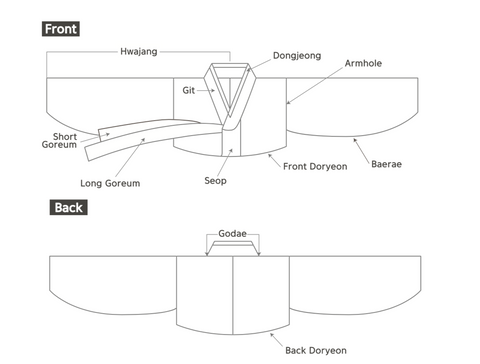
But before we go into the different types of hanbok, let's go over the basic hanbok terms:
Basic Hanbok Terms
Baerae:
Bottom curves of the sleeves of jeogori, to be more specific, the part ranging from the end of the sleeve to the jindong.
Boseon:
The traditional socks worn with hanbok and hanbok shoes. They are traditionally white with floral embroidery.
Gil:
The broad body part of upper garment
Git:
The neckline part of jeogori
Godae:
The backside of the git which is attached between shoulder seams.
Goreum:
Two strings attached to the front part of jeogori or durumagi in order to fold the clothes.
Gyeotmagi:
The armpit part of jeogori.
Kkeutdong:
A cloth of a different color attached to the edges of the sleeves of jeogori.
Seop:
A cloth attached to the front part of upper garments such as jeogori or durumagi, in order to prevent them from being opened.
Sunuk:
The seams of beoseon.
The Different Types of Jeogori (Hanbok Blouse)
This is where the fashionable fun comes in! There are many different types of jeogori that women can wear. While the chima stays the same in length (for traditional hanbok; modern hanbok is a completely different story), the jeogori is diverse and each has its own characteristic look.
1. Min Jeogori
This blouse is short and single-colored. It is a plain jeogori that is commonly worn with daily wear hanbok. It conveys a casual vibe and is preferred during the summer when people want to wear lighter, cooler fabrics such as linen for the hot summer fashion.

2. Hoijang Jeogori
The hoijang jeogori is a jeogori that has different colored patches on various parts of the blouse. The colored patches can be on the edges (cuffs) of the sleeves, at the collar, or at the ties of the blouse. It is usually two-toned, meaning there is a primary color for the blouse and a secondary color for the cuff and collar patches. It is considered classic Korean hanbok design to make them contrasting colors, yet not tacky or clashing.
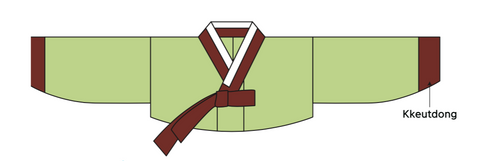
3. Samhoijang Jeogori
Samhoijang jeogori is a jeogori where the collar, ties, under arm area (called gyeotmagi) and the sleeve cuffs have a different color from the main part of jeogori. It is similar to the hoijang jeogori, but less commonly seen.
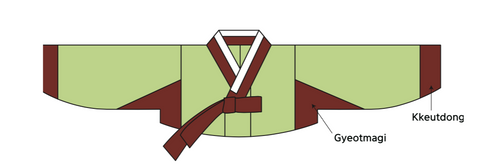
4. Saekdong Jeogori
The saekdong jeogori is a jeogori that has multicolor striped sleeves. You'll often see this kind of jeogori worn by toddlers, children, or young adults as it conveys brightness and vibrance. Adult women can wear it too, especially for happy occasions such as Korean Lunar New Years, but it is more common amongst children or unmarried women as color conveys social status and is significant to Korean design.
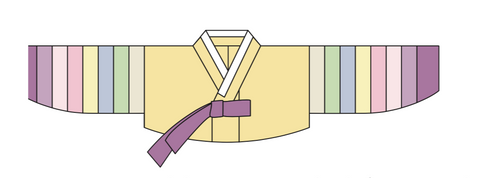
The Royal Blouse, the Dangui
There is one type of top that is special and beautiful -- so much so that it deserves its own section in this article: the royal dangui. The dangui was part of the Korean royal court attire and ceremonial outfit for women during the Joseon Dynasty. Today, the dangui is now widely loved and popular choice for wedding hanbok attire, due to its elegant shape, gorgeous decorative patterns, and classic beauty.
If you've watched a Korean historical drama before, you've probably seen how the women at the royal court, such as the queen, the queen mothers, the princesses, and high-ranking court ladies wear a different types of hanbok top than the common women. This is the dangui, a semi-formal jacket with side slits. The dangui was worn by female members of the royal family as the official garments for ceremonies and for daily activity. It was also worn by royal court ladies who served the royal females, yet the materials were different and decorations were different as well. Women of high social status wore the dangui when they would go to the royal courts, and also as part of their formal bridal hanbok attire.

The dangui is similar to the jeogori, but the difference is in the narrow sleeves. The length of the sleeves reaches to the knees, as the front and back panels are longer than those of the jeogori. The hem is curved and the side seams are open to the armpit so that it has 3 panels: 2 in the front and 1 in the back.
There were a variety of colors of dangui: purple, dark green, yellowish green, and white. The yellowish green color was the most common. The lining of the dangui, however, was mainly red and the ribbons at the chest were of purple hues. White cuffs called geodeulji were attached to the ends of the sleeves.
The dangui for queens and princess were decorated with geumback (gold leaf) patterns from the shoulder down to the end of the sleeves. They were also embellished on the front panel, back panel, and the goreums. These patterns were traditionally flowers, bats, or lucky Chinese characters for words such as longevity, fortune, or happiness. The queen, however, worn a very special phoenix pattern.
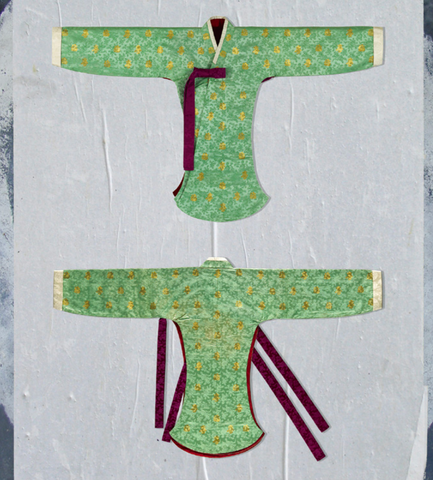
The dangui also changed according to the season. For example, there were these common types:
- Single-layered dangui
- Double-layered dangui
- Quadruple-layered dangui
- Single-layered dangui with tapered bottom hemline
Although there aren't any royalty walking amongst the halls of Korea's palaces today, many women choose to wear dangui's as part of their engagement photoshoots or weddings so that they can feel like royalty. And who can blame them? The dangui is a beautiful traditional attire.
The Style Evolution of Hanbok
The traditional hanbok has changed over time to keep up with the trends and style of the women at that time. We can see the evolution of the hanbok through depictions in literature and drawing from various time periods of Korea's past history.
Hanbok from the 16th century to today:
• Late 16th century: The most classic, traditional hanbok attire style is depicted in literature was a silhouette from the late 16th century. It is deduced by scholars and historians that the hanbok at this time was a ceremonial dress, worn for special occasions or festivals that they needed to prepare. At that time, the women were not allowed to participate in festivals or rituals. The flowing skirt and hemline conveys a sense of movement and lyricism.
• Early 18th century: More than the hanbok of the women of the past areas, the hanbok of the early 18th century was a simple or plain dress, with the jeogori coming down to the waist. The skirt was now an abundant and roomy skirt. However, the skirt cut off at the ankle, revealing the wearers' shoes.
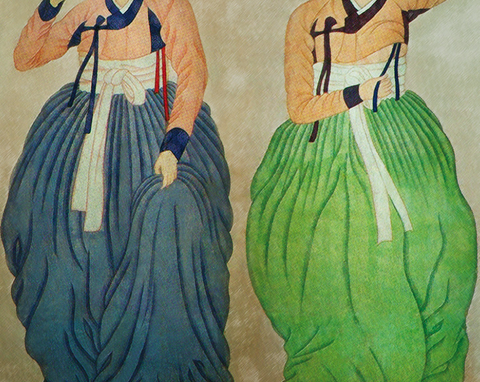
• Late 18th century: The hanbok evolved by this time into a narrow waist with the jeogori being tighter on top and more close to the body (close-fitting). The skirt, on the other hand, became much more round and full -- like a balloon that swelled up. There are a lot of curves featured in this silhouette.
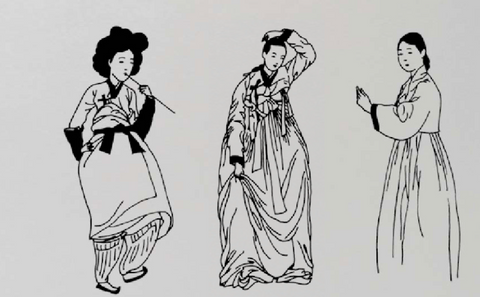
• Late 18th century: The comfort of the large and wide skirt was intensified by the large cloth that people used to tie their chima around their waist. The hairstyle at that time was to have a large, voluminous updo to go along with the jeogori and the chima. From the top to the bottom, the overall silhouette that the wearer had while wearing this was of large (heavy) on top, to small in the middle of the body (light), and back to large (heavy) on the bottom.

• 19th century: The hairstyle became much smaller in the 19th century, and there came great design changes to the overall silhouette of the hanbok as well. The folds of the dress became a lot more, the chima became more roomy with a lot of folds and became longer, reaching down to the ground. While the previous silhouette of the hanbok in the late 18th century featured a tension between the conflicting components of the hanbok, the hanbok of the 19th century seemed like the clothing flowed together from top to bottom, likes waves cascading upon one another. The overall look became very soft.
• Late 19th century: The clothing was originally narrow, not leaving a lot of room for the wearer, but the sleeves of the top became a lot wider in the hanbok worn by women in the 19th century. The chima, on the other hand, became more simple and modest, taking away the numerous folds and wave-like look of the previous decades. The overall silhouette became more natural looking and seemed to drape down the body very naturally from top to bottom, while retaining its overall roundness.
• Today: Today, as the hanbok has become relegated to mainly ceremonial and formal dress, the traditional style of hanbok has not changed for a long time. It retains the look of the late 19th century and the 20th century, as Koreans associate the hanbok with tradition, history, heritage, and the old ways of life in Korea.
There has been a big silhouette change, however, in the realm of modern hanbok, a term given for contemporary hanbok styles that have been greatly altered by incorporating new silhouettes, new components, and Western-style shapes and forms.

In the past, the chima was a staple of women's hanbok, despite the various changes throughout the centuries in the length, material, and volume of the hanbok. But today, women's hanbok is no longer restricted to just a jeogori and chima variation. Today's hanbok has women also in different silhouettes of baji (pants) that often mimic the look of a chima with its flowing layers (as pictured above) or in a straight-down style like that of a men's hanbok baji (pants, trousers).
There you have it! Your comprehensive guide to women's hanbok.
These are only the templates of how women's hanbok can look. Today, there are many designers who are pushing the envelope and exploring new materials, patterns, and cuts to the hanbok design to bring Western-style influences and infuse the traditional hanbok with modern style. These designs are called "modern hanbok."
If you want to learn more about modern hanbok, check out our Modern Hanbok blog.






